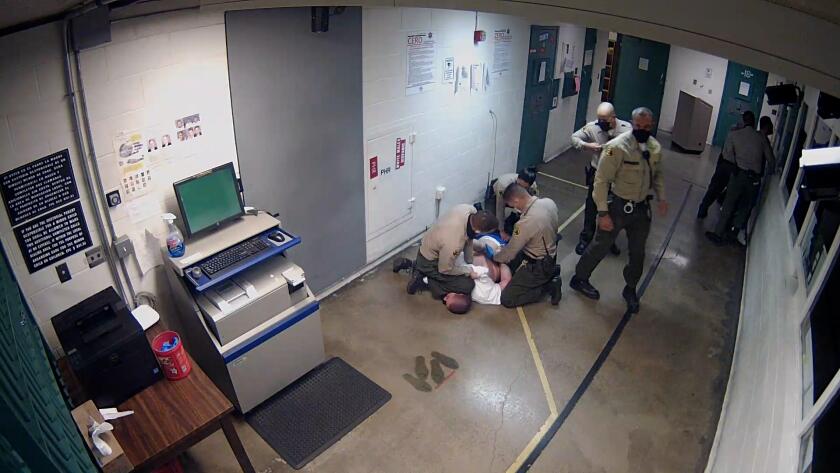Grand jury investigating L.A. County Sheriff’s Department handling of deputy who knelt on inmate’s head
- Share via
Los Angeles County sheriff’s officials attempted to hide an incident in which a deputy kneeled on the head of an inmate for three minutes while the man was handcuffed.
- Share via
Los Angeles County prosecutors are convening a criminal grand jury to investigate whether the Sheriff’s Department mishandled an incident in which a sheriff’s deputy knelt on a handcuffed inmate’s head for three minutes, according to documents and interviews.
Several subpoenas have been served ordering sheriff’s officials to appear and testify starting later this week, according to two sources with knowledge of the subpoenas. Prosecutors are also seeking communications by a number of sheriff’s executives, one of the sources said.
It’s unclear how many subpoenas were issued or who received them. It’s also unclear whom prosecutors are targeting in their investigation. The district attorney’s office on Monday declined to comment.
The activity is a major development in the case. Sheriff Alex Villanueva has been accused by three high-level executives of trying to keep the March 2021 incident — exposed by The Times this year — under wraps. The incident drew national attention when Villanueva announced that the reporter who wrote the story was under criminal investigation. He quickly took back those remarks.
Villanueva said in a statement Monday that the department was notified last week of a criminal grand jury subpoena for records related to the incident and that “we are conducting a thorough internal investigation, and we are fully cooperating with this subpoena.”
He added: “To date, our investigation indicates that the allegation of misconduct was orchestrated by involved Department executives to falsely portray themselves as whistleblowers in order to avoid discipline, up to and including termination. The District Attorney has been given this and all other relevant information.”
It’s unclear whether prosecutors are seeking indictments from the grand jury. A grand jury may be impaneled either to bring indictments or to perform criminal investigations. Prosecutors may choose to use an investigative grand jury to test the evidence and get witnesses on the record, said Alan Jackson, a former prosecutor who now works as a criminal defense attorney.
“It’s a tool that the prosecution uses to thoroughly investigate the circumstances of a crime or suspected crime or suspected set of circumstances,” Jackson said. “An investigative grand jury may come back with the opinion, the determination that there is no crime.”
The investigative grand jury can also recommend charges, which prosecutors can file down the line, whereas an indictment grand jury is “responsible for looking for evidence that was already put together by prosecution,” Jackson said.
Inspector General Max Huntsman, who provides oversight of the Sheriff’s Department, said Monday he’s “pleased to see the investigative grand jury being put to use here.” He added: “The Sheriff’s Department has refused to cooperate with our subpoenas and I’m optimistic that they will find it more difficult to resist grand jury subpoenas.”
The incident happened on the morning of March 10, 2021, two days after jury selection had begun 1,500 miles away in the trial of Derek Chauvin, the former Minneapolis police officer who would be convicted of murdering George Floyd by kneeling on his neck.
At the San Fernando Courthouse, deputies were conducting routine searches of inmates before their court appearances when deputies told two inmates to be quiet.
As the pair continued talking and laughing, Deputy Douglas Johnson ordered one of them, Enzo Escalante, to stop and face the wall. Escalante was awaiting trial on multiple charges, including murder.
Security video obtained by The Times shows Johnson walking closely behind Escalante through a hallway before ushering him toward a wall.
Escalante turned around and punched Johnson in the face multiple times. Johnson and other deputies then took Escalante to the ground, positioning him facedown.
After he was handcuffed, Johnson kept his knee on Escalante’s head for three minutes.
Johnson is the deputy who took gruesome photos that were passed around of the scene of the helicopter crash that killed Lakers legend Kobe Bryant, his daughter and seven others. He is expected to testify in Vanessa Bryant’s highly publicized trial against L.A. County, which is set to start this week.
In an internal force review, Cmdr. Allen Castellano wrote that department officials were worried about the optics of the kneeling, “given its nature and its similarities to widely publicized George Floyd use of force.”
Those officials decided not to pursue assault charges against the inmate to avoid drawing attention to the incident, the report said.
The Times in March published video of the incident and detailed efforts by department officials to keep it quiet.
After The Times report, Villanueva said he first learned of the case eight months after it occurred, in November, and immediately ordered a criminal investigation into whether the deputy had used excessive force on the inmate.
But former Assistant Sheriff Robin Limon, who was once one of Villanueva’s top advisors, alleged in a legal claim that she personally brought a DVD containing a video of the incident to Villanueva — and watched it with him and two others just five days after it happened. After The Times report, Villanueva demoted Limon over the incident.
Backing up her claim that Villanueva saw the video right after it happened, Limon alleged, was the fact that the sheriff removed one of the supervising deputies from a promotional list for sergeant shortly after the incident because he was being investigated administratively for failing to intervene when the deputy was pinning down the inmate.
She said the two others in the room when she watched the video with Villanueva were Undersheriff Tim Murakami and the sheriff’s lieutenant aide at the time, Anthony Blanchard.
Both of them publicly disputed Limon’s version of events.
When questioned at a news conference in April, Murakami said the allegation that he saw the video in March 2021 was false.
Blanchard’s response was more ambiguous. He said that “the video was never seen in March the way it was presented.” Blanchard has since been promoted to captain and is now listed on a Sheriff’s Department organizational chart as the head of the personnel administration bureau.
In May, Villanueva’s chief of staff, Cmdr. John Satterfield, wrote a memo that purported to knock down Limon’s claims.
The report included the results of a forensic analysis of a computer workstation on the day in November Villanueva said he first watched the video. But there was no forensic analysis done of any computer from March 2021, when Limon alleged she watched the video with Villanueva alongside Murakami and Blanchard.
Satterfield, who said he watched the video on Nov. 18 with the sheriff on Skype, wrote: “It was also obviously clear, based on the Sheriff’s statements and reactions, that he had never seen the video before or been made aware of it.”
More to Read
Sign up for Essential California
The most important California stories and recommendations in your inbox every morning.
You may occasionally receive promotional content from the Los Angeles Times.












